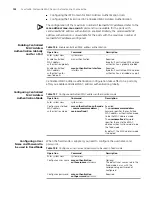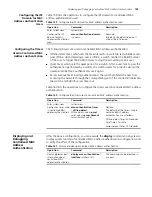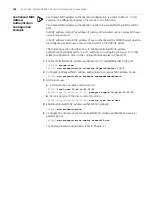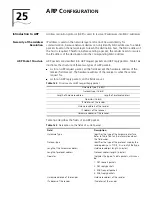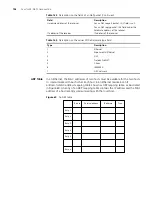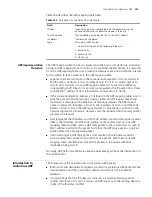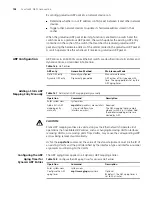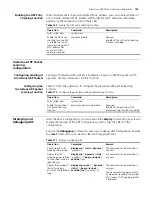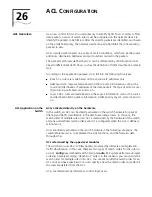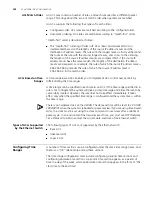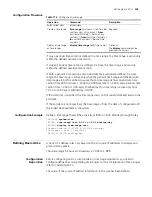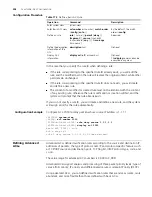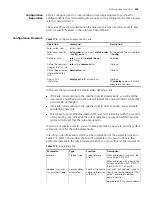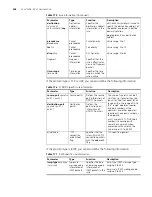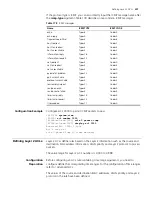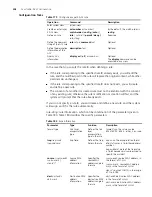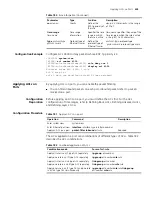
206
C
HAPTER
26: ACL C
ONFIGURATION
If the protocol type is TCP or UDP, you can also define the following information:
If the protocol type is ICMP, you can also define the following information:
destination
{
dest-addr
dest-wildcard
|
any
}
Destination
address
information
Specifies the
destination address
information in the
rule
dest-addr dest-wildcard
is used to
specify the destination address of
the packet, expressed in dotted
decimal notation
any
represents any destination
address
precedence
precedence
Packet
precedence
Packet priority
Value range: 0 to 7
tos
tos
Packet
precedence
ToS priority
Value range: 0 to 15
dscp
dscp
Packet
precedence
DSCP priority
Value range: 0 to 63
fragment
Fragment
information
Specifies that the
rule is effective for
non-initial fragment
packets
-
time-range
time-name
Time range
information
Specifies the time
range in which the
rule is active
-
Table 176
TCP/UDP-specific rule information
Parameter
Type
Function
Description
source-port
operator
port1
[
port2
]
Source port(s)
Defines the source
port information of
UDP/TCP packets
The value of
operator
can be lt
(less than), gt (greater than), eq
(equal to), neq (not equal to) or
range (within the range of) Only
the “range” operator requires
two port numbers as the
operands, and other operators
require only one port number as
the operand
port1
and
port2
: TCP/UDP port
number(s), expressed with
name(s) or numerals; when
expressed with numerals, the
value range is 0 to 65,535
destination-port
operator port1
[
port2
]
Destination
port(s)
Defines the
destination port
information of
UDP/TCP packets
established
“TCP
connection
established”
flag
Specifies that the
rule will match TCP
connection packets
with the
ack
or
rst
flag
TCP-specific argument
Table 177
ICMP-specific rule information
Parameter
Type
Function
Description
icmp-type
icmp-type
icmp-code
Type and
message code
information of
ICMP packets
Specifies the type
and message code
information of
ICMP packets in the
rule
icmp-type
: ICMP message type,
ranging 0 to 255
icmp-code
: ICMP message code,
ranging 0 to 255
Table 175
Rule information (Continued)
Parameter
Type
Function
Description
Summary of Contents for 4200G 12-Port
Page 10: ...8 CONTENTS...
Page 14: ...4 ABOUT THIS GUIDE...
Page 46: ...32 CHAPTER 5 LOGGING IN THROUGH WEB BASED NETWORK MANAGEMENT SYSTEM...
Page 48: ...34 CHAPTER 6 LOGGING IN THROUGH NMS...
Page 60: ...46 CHAPTER 9 VLAN CONFIGURATION...
Page 64: ...50 CHAPTER 10 MANAGEMENT VLAN CONFIGURATION...
Page 80: ...66 CHAPTER 13 GVRP CONFIGURATION...
Page 98: ...84 CHAPTER 15 LINK AGGREGATION CONFIGURATION...
Page 112: ...98 CHAPTER 18 MAC ADDRESS TABLE MANAGEMENT...
Page 126: ...112 CHAPTER 19 LOGGING IN THROUGH TELNET...
Page 162: ...148 CHAPTER 20 MSTP CONFIGURATION...
Page 274: ...260 CHAPTER 29 IGMP SNOOPING CONFIGURATION...
Page 276: ...262 CHAPTER 30 ROUTING PORT JOIN TO MULTICAST GROUP CONFIGURATION...
Page 298: ...284 CHAPTER 33 SNMP CONFIGURATION...
Page 304: ...290 CHAPTER 34 RMON CONFIGURATION...
Page 338: ...324 CHAPTER 36 SSH TERMINAL SERVICES...
Page 356: ...342 CHAPTER 38 FTP AND TFTP CONFIGURATION...
Page 365: ...Information Center Configuration Example 351 S4200G terminal logging...
Page 366: ...352 CHAPTER 39 INFORMATION CENTER...
Page 378: ...364 CHAPTER 40 BOOTROM AND HOST SOFTWARE LOADING...
Page 384: ...370 CHAPTER 41 Basic System Configuration and Debugging...
Page 388: ...374 CHAPTER 43 NETWORK CONNECTIVITY TEST...
Page 406: ...392 CHAPTER 45 CONFIGURATION OF NEWLY ADDED CLUSTER FUNCTIONS...

